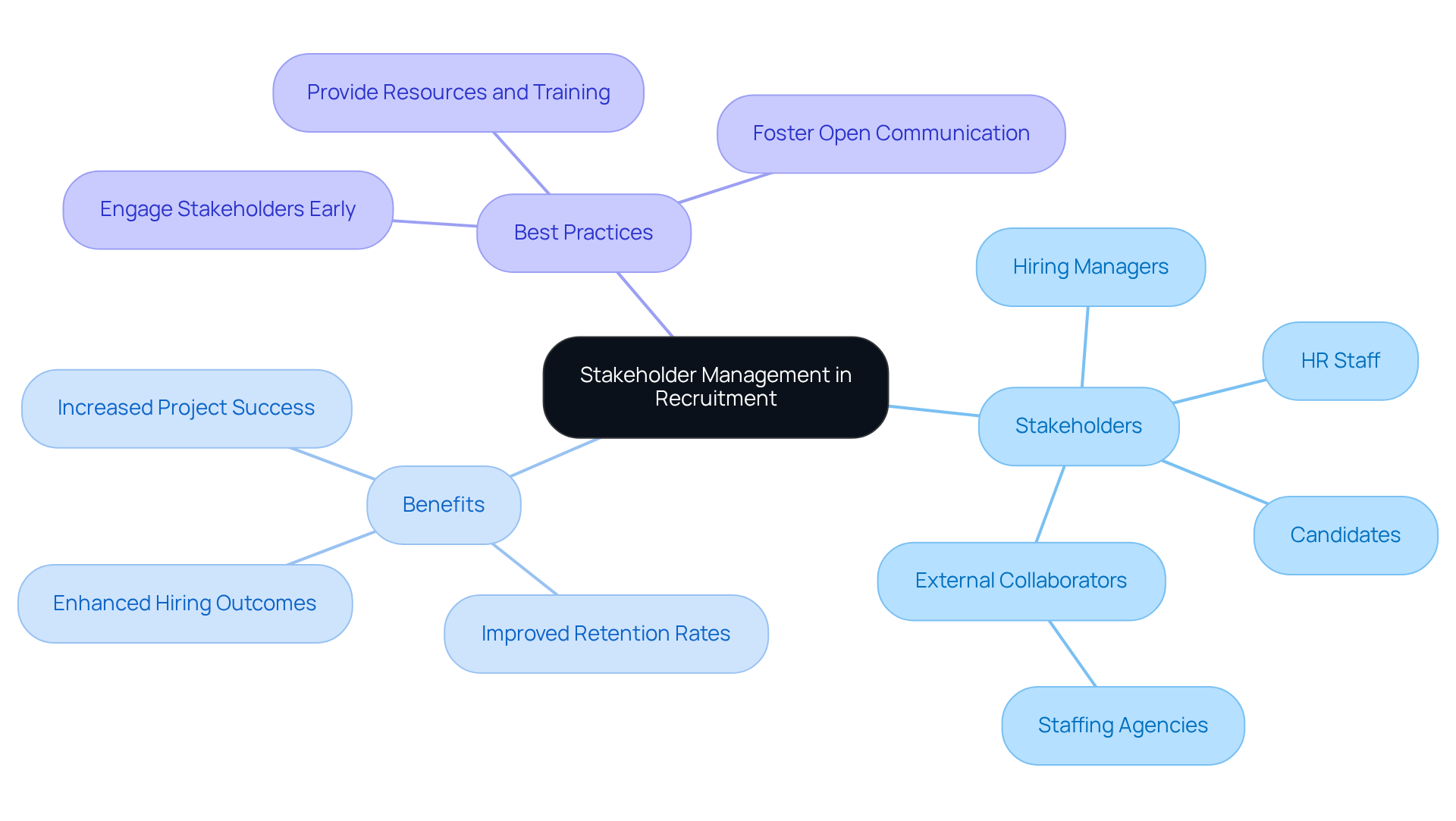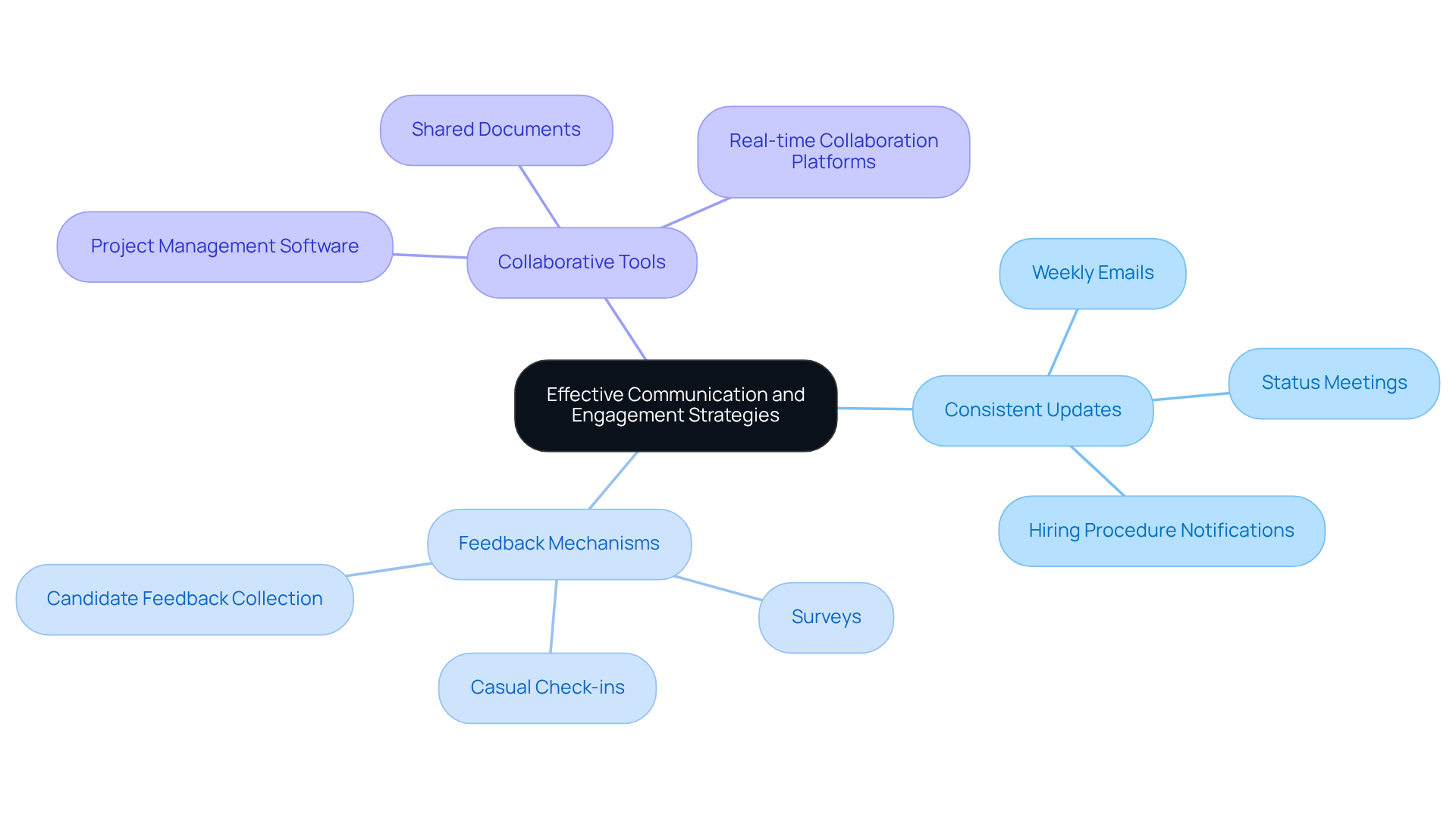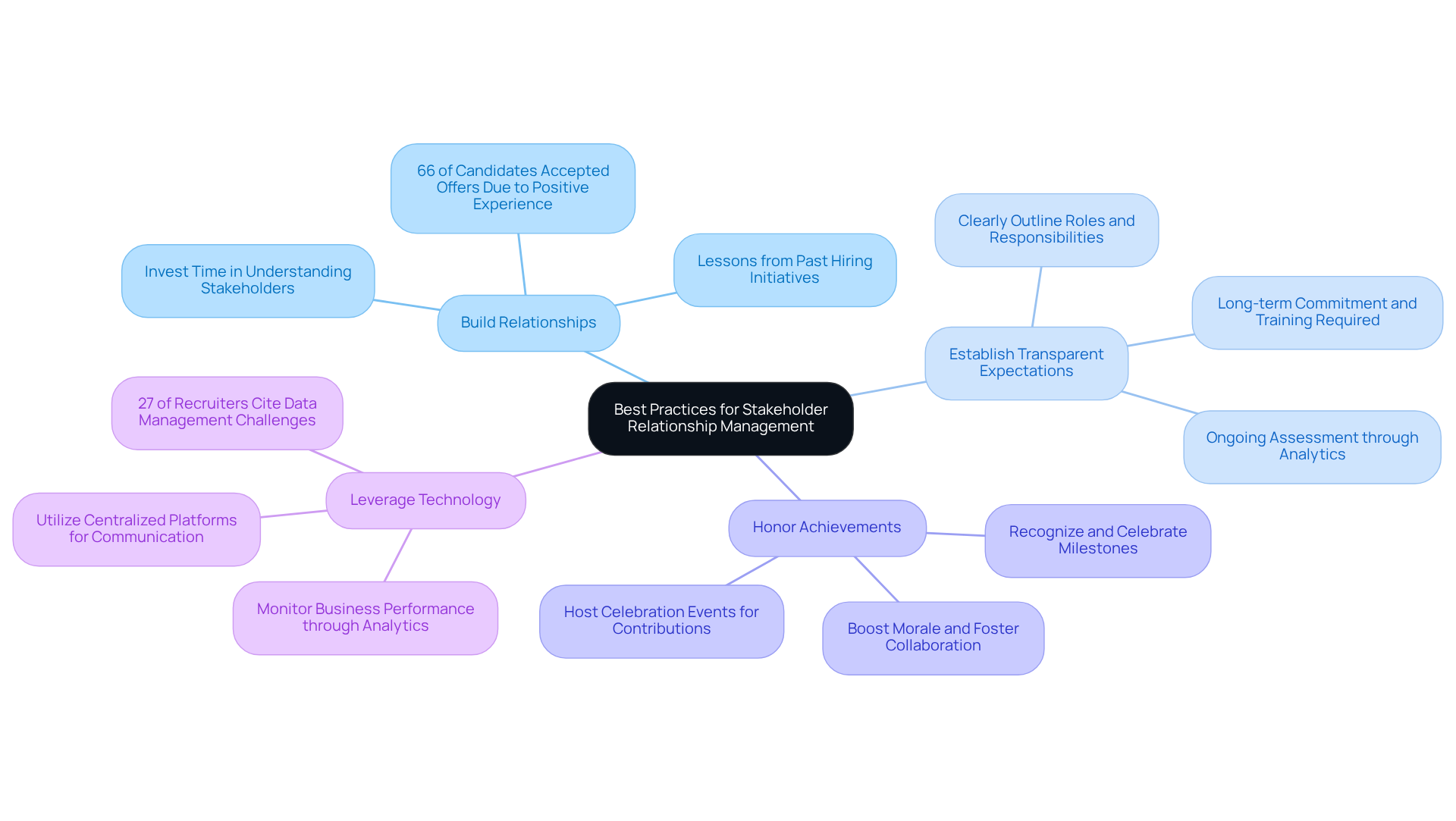Overview
This article presents four essential strategies for effective recruitment stakeholder management. It underscores the significance of:
- Identifying stakeholders
- Establishing robust communication channels
- Implementing best practices to foster collaboration throughout the hiring process
By actively engaging stakeholders—including hiring managers and candidates—and leveraging technology for transparent communication, organizations can substantially enhance recruitment outcomes and bolster employee retention. Statistics clearly demonstrate the advantages of stakeholder involvement in achieving these goals.
Introduction
Recruitment transcends mere vacancy filling; it relies on the complex relationships among diverse stakeholders, each contributing unique insights and expectations to the hiring process. By mastering recruitment stakeholder management, organizations can harmonize these interests, fostering collaboration that elevates the overall hiring experience. Yet, a pressing challenge persists: how can companies effectively engage all parties—from hiring managers to candidates and external partners—to ensure a streamlined and successful recruitment process? This article explores four pivotal strategies that can transform stakeholder management into a formidable tool for achieving hiring success.
Define Stakeholder Management in Recruitment
Recruitment stakeholder management in hiring demands a strategic approach to identifying, analyzing, and engaging individuals or groups with a vested interest in the hiring process. This encompasses hiring managers, HR staff, candidates, and external collaborators such as staffing agencies. By adeptly utilizing recruitment stakeholder management, organizations can manage these stakeholders effectively, align all parties with hiring objectives, thereby promoting cooperation and enhancing the overall hiring experience.
For example, a retail business grappling with high turnover rates can significantly benefit from managing interests by actively involving store managers in the hiring process. This collaboration ensures that the candidates selected resonate with the store's culture and operational needs, ultimately leading to improved retention rates and a more cohesive work environment. Such proactive involvement in recruitment stakeholder management not only streamlines the hiring procedure but also cultivates a sense of ownership among participants, resulting in enhanced hiring outcomes.
As Simon observes, "Driving change isn’t solely about informing involved parties about why change is significant and what their role ought to be. It’s also about empowering everyone involved with the resources and training to act." This underscores the importance of equipping participants to engage effectively in the recruitment process. Furthermore, statistics reveal that companies that engage with stakeholders are 30% more likely to succeed with new products, highlighting the critical role of such involvement in achieving organizational goals. By prioritizing the engagement of stakeholders, organizations can anticipate a 15% increase in employee retention, demonstrating the tangible benefits of this strategic approach.

Identify Key Stakeholders in Recruitment
Effective management of involved parties in hiring is essential for successful recruitment stakeholder management, starting with identifying key participants in the process. The primary stakeholders typically encompass:
- Hiring Managers: They define job requirements and make final hiring decisions, making their input essential for successful staffing.
- HR Experts: These individuals support the hiring process, ensuring compliance with policies and procedures while enhancing the candidate experience.
- Candidates: Their feedback and experiences offer valuable insights that can refine hiring strategies and improve overall effectiveness.
- External Partners: This group includes hiring agencies and consultants who assist in sourcing candidates and provide additional expertise.
Mapping these stakeholders is a crucial aspect of recruitment stakeholder management, enabling organizations to tailor their hiring strategies to meet the specific needs and expectations of each group. For instance, engaging hiring managers early in the selection phase can enhance operations, as they offer insights on the critical skills and qualities required for success in the role. This collaborative approach not only elevates the quality of hires but also fosters a more effective hiring system, addressing the challenges many organizations face in sourcing the right talent.

Establish Effective Communication and Engagement Strategies
Effective communication and engagement techniques are pivotal for the successful recruitment stakeholder management of interested parties in hiring. Consider the following key best practices:
- Consistent Updates: Keep interested parties informed about the hiring procedure, schedules, and any modifications that may occur. This can be achieved through weekly emails or status meetings, ensuring everyone is on the same page.
- Feedback Mechanisms: Establish channels for participants to provide feedback on the recruitment process. This could involve surveys or casual check-ins, enabling ongoing enhancement based on feedback from involved parties.
- Collaborative Tools: Utilize technology platforms that enable real-time collaboration and information exchange among participants, such as project management software or shared documents. This enhances transparency and keeps everyone engaged.
By encouraging transparent communication in recruitment stakeholder management, organizations can establish trust and ensure that all participants feel appreciated and listened to. For instance, a hospitality business might conduct regular meetings with department heads to discuss candidate progress, ensuring alignment and promptly addressing any concerns. This proactive method not only boosts participant involvement but also aids in a more efficient hiring process.

Implement Best Practices for Stakeholder Relationship Management
To implement best practices for stakeholder relationship management in recruitment, consider the following strategies:
- Build Relationships: Invest time in understanding the needs and expectations of each stakeholder. This can involve one-on-one meetings or informal discussions to foster rapport. Notably, 66% of candidates accepted offers due to a positive experience, underscoring the significance of relationship building in hiring. By applying lessons learned from past hiring initiatives, you can improve recruitment stakeholder management and forge stronger, enduring connections that enhance teamwork.
- Establish Transparent Expectations: Clearly outline roles and responsibilities for each participant in the hiring process to prevent misunderstandings and ensure accountability. As noted by hireEZ, "Successful adoption requires a long-term commitment that involves comprehensive training, clear communication of benefits, and continuous support," which is vital for setting clear expectations. Ongoing assessment of hiring performance through analytics can aid in refining these expectations over time.
- Honor Achievements: Recognize and celebrate milestones and successes in the hiring journey with all involved parties. This practice can boost morale and foster continued collaboration. For instance, a small enterprise might host a celebration event after successfully filling a crucial role, inviting everyone involved in the process. This not only acknowledges their contributions but also strengthens connections for future hiring initiatives.
- Leverage Technology: Utilize technology to streamline communication and uphold transparency among stakeholders. Establishing a centralized platform can enhance collaboration and ensure that everyone is aligned on recruitment stakeholder management, as well as hiring objectives and progress. This approach can significantly improve the overall efficiency of the recruitment process. Furthermore, by continuously monitoring business performance through real-time analytics, you can address common pitfalls, such as the 27% of recruiters who cite data management challenges, thereby helping to avoid potential missteps in stakeholder management.

Conclusion
Effective recruitment stakeholder management is an essential component in achieving successful hiring outcomes. By strategically identifying and engaging all parties involved in the recruitment process, organizations can foster collaboration, enhance communication, and ultimately align their hiring objectives with the needs of their stakeholders. This proactive approach streamlines the recruitment process and cultivates a sense of ownership among participants, leading to improved retention rates and a more cohesive work environment.
The article highlights key strategies for effective stakeholder management, including the identification of primary stakeholders such as:
- Hiring managers
- HR experts
- Candidates
- External partners
Establishing clear communication channels and feedback mechanisms is crucial for maintaining transparency and trust among participants. Moreover, implementing best practices—such as building relationships, setting transparent expectations, recognizing achievements, and leveraging technology—can significantly enhance stakeholder engagement and collaboration throughout the hiring process.
In conclusion, prioritizing stakeholder management in recruitment is not merely a best practice; it is a necessity for organizations aiming to attract and retain top talent. By actively involving all stakeholders and fostering an environment of open communication and collaboration, companies can markedly improve their hiring outcomes. Embracing these strategies will lead to a more effective recruitment process, ultimately contributing to the overall success and growth of the organization.
Frequently Asked Questions
What is stakeholder management in recruitment?
Stakeholder management in recruitment involves a strategic approach to identifying, analyzing, and engaging individuals or groups with a vested interest in the hiring process, including hiring managers, HR staff, candidates, and external collaborators like staffing agencies.
Why is stakeholder management important in recruitment?
Effective stakeholder management aligns all parties with hiring objectives, promotes cooperation, and enhances the overall hiring experience, leading to better hiring outcomes.
How can involving store managers in the hiring process benefit a retail business?
Actively involving store managers can ensure that selected candidates resonate with the store's culture and operational needs, ultimately improving retention rates and creating a more cohesive work environment.
What does Simon suggest about driving change in recruitment?
Simon emphasizes that driving change involves not only informing parties about the significance of change but also empowering them with the resources and training needed to engage effectively in the recruitment process.
What are the benefits of engaging stakeholders in the hiring process?
Companies that engage with stakeholders are 30% more likely to succeed with new products and can anticipate a 15% increase in employee retention, demonstrating the tangible benefits of this strategic approach.




